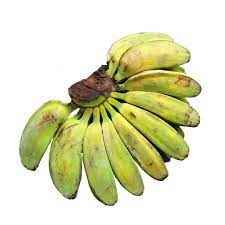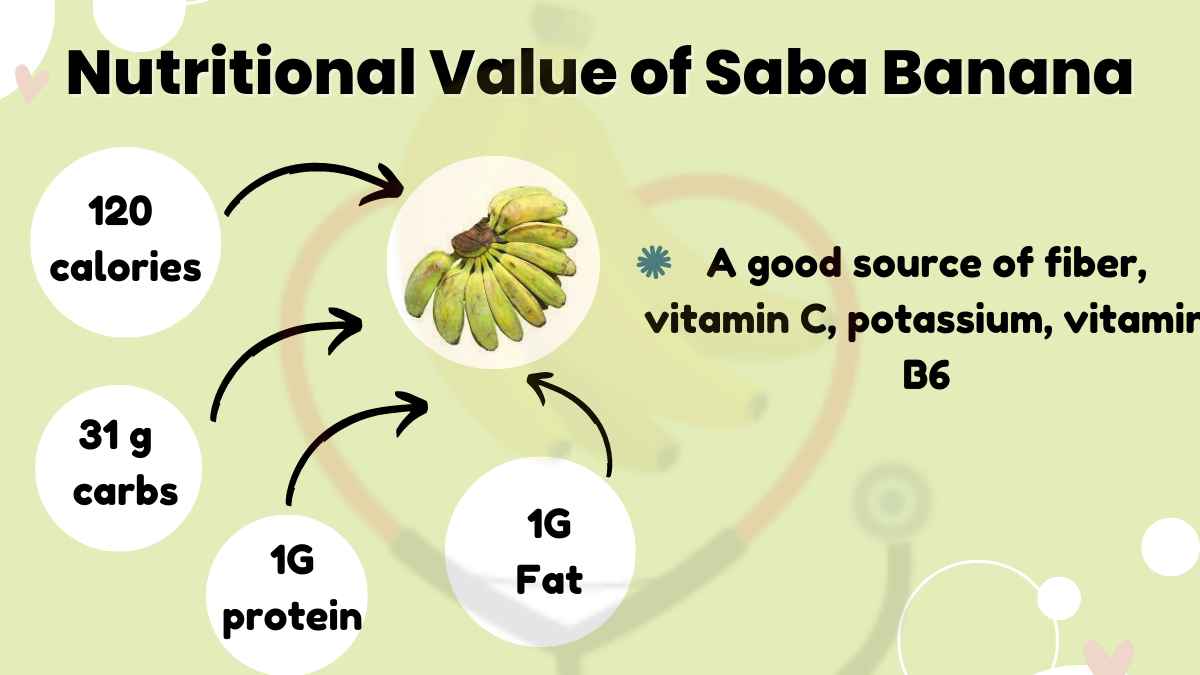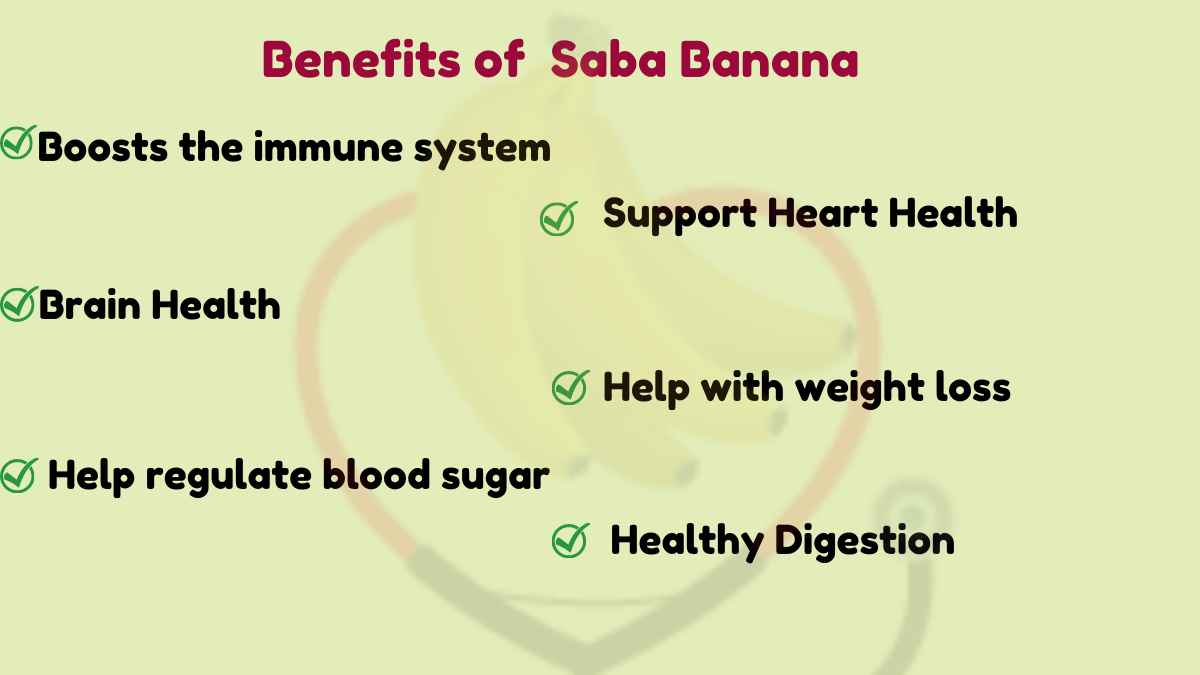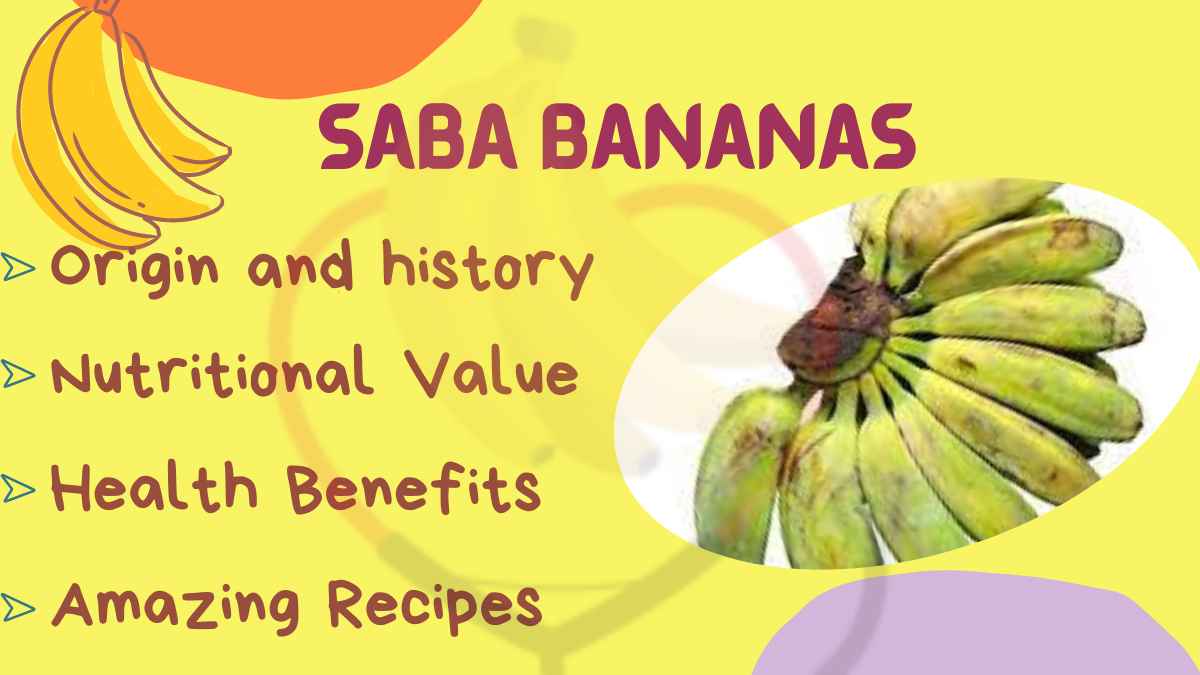Saba banana is a popular type of banana from Southeast Asia. They are starchy when unripe, but become sweet and creamy when ripe.
Saba bananas are originated in the Philippines. They are known for their large size, thick skin, and starchy texture. [1]
Saba bananas are primarily used for cooking, as they are not as sweet as other varieties of bananas and have a lower sugar content.
In this article, we will discuss the Saba bananas, their characteristics, nutritional value, health benefits, and culinary uses.

Origin of Saba Bananas
Saba bananas, also known as the Cardava banana, are a type of banana primarily grown in the Philippines. They are believed to have originated from the Southeast Asian region and were introduced to the Philippines during the Spanish colonial period.
Saba bananas are a staple food in the Filipino diet, and are commonly used in traditional dishes such as turon, banana cue, and ginataang halo-halo.
The bananas are also exported to other countries, such as Japan and the United States, and are used in various culinary applications, such as baking and cooking.
Characteristics of Saba Bananas
Here are some characteristics of Saba Bananas:
- Saba bananas are a type of banana primarily grown in the Philippines and other Southeast Asian countries.
- They are generally larger and firmer than other types of bananas, with a blocky, rectangular shape and thick skin that turns from green to yellow as the fruit ripens.
- The flesh of Saba bananas is cream-colored and firm, with a slightly starchy texture and a subtle sweetness.
- Saba bananas are commonly used in traditional Filipino dishes such as turon (deep-fried banana rolls), banana cue (skewered and caramelized bananas), and ginataang halo-halo (a sweet stew made with coconut milk, root crops, and Saba bananas).
- They are also exported to other countries, such as Japan and the United States, where they are used in baking and cooking.
- Saba bananas are a good source of fiber, vitamins B6 and C, and potassium.
- They are relatively easy to grow and are resistant to many banana diseases, making them a popular choice for small-scale farmers in the Philippines.
- Saba banana production is an important industry in the Philippines, providing employment and income to many farmers and agricultural workers.
Nutritional Value of Saba Bananas
Saba bananas are a good source of essential vitamins and minerals. One medium-sized Saba banana contains approximately; [2]

- 120 calories
- 31 grams of carbohydrates
- 1 gram of protein
- 1 gram of fat
- They are also a good source of fiber, vitamin C, potassium, and vitamin B6.
Health Benefits of Saba Bananas
Saba bananas offer a number of health benefits. Certainly! Here are some health benefits of Saba bananas: [3]

1: Healthy Digestion
Saba bananas are a good source of dietary fiber, which can help promote healthy digestion and prevent constipation. [4]
2: Support Heart Health
Saba bananas are high in potassium, an important mineral that helps regulate blood pressure and support heart health. [5]
3: Boost Immune system
Saba bananas are a good source of vitamin C, which can help boost the immune system and protect against infections and diseases. [6]
4: Brain Health
Saba bananas are also a good source of vitamin B6, which plays a key role in brain function and the production of hormones and neurotransmitters. [7]
5: Low in fat
Saba bananas are naturally low in fat and cholesterol, making them a healthy snack option.
6: Help regulate blood sugar
Saba bananas have a low glycemic index, which means they can help, regulate blood sugar levels and prevent spikes and crashes. [8]
7: Help with weight loss
Saba bananas are a good source of fiber and are low in calories, which can help promote feelings of fullness and support weight loss goals.
8: Help improve mood
Saba bananas contain tryptophan, an amino acid that can help improve mood and reduce stress and anxiety. [9]
9: Help with bone health
Saba bananas contain a variety of minerals, including calcium and magnesium, which are important for maintaining strong and healthy bones.
Culinary Uses of Saba Bananas
Saba bananas are primarily used for cooking, as their starchy texture makes them ideal for a variety of dishes. Certainly! Here are some common culinary uses of Saba bananas:
Turon: Saba bananas are often used as the main ingredient in turon, a popular Filipino snack made by rolling a slice of banana and a strip of jackfruit in a spring roll wrapper, and deep-frying until crispy. It is commonly served with a sweet sauce made with brown sugar and vanilla.
Banana cue: Saba bananas are also commonly used in banana cue, a popular street food in the Philippines. The bananas are skewered, coated in brown sugar, and then fried until caramelized and golden brown.
Ginataang halo-halo: Saba bananas are used in this sweet stew, along with other ingredients such as sweet potatoes, taro, and coconut milk.
Baked goods: Saba bananas are often used in baking, particularly in breads and cakes. They add a natural sweetness and moisture to the baked goods.
Desserts: Saba bananas can be used to make a variety of desserts, such as banana fritters, banana pudding, and banana pie.
Smoothies and shakes: Saba bananas can be blended with other fruits and milk to make delicious and nutritious smoothies and shakes.
Savory dishes: Saba bananas can also be used in savory dishes, such as stews and curries. They add a slightly sweet flavor and texture to the dish.
Saba Bananas vs. Other Bananas
Saba bananas are different from other varieties of bananas in several ways. They are larger and less sweet than other bananas, and have a starchy texture that makes them ideal for cooking. While other varieties of bananas are often eaten raw, Saba bananas are primarily used for cooking.
Recipes of Saba Banana
Here are three recipes that use Saba bananas:
Turon (Filipino Banana Rolls)
Ingredients:
- 5 Saba bananas, sliced lengthwise
- 10 spring roll wrappers
- 1/2 cup brown sugar
- 1 tsp. vanilla extract
- Oil for frying
Instructions:
- Mix the brown sugar and vanilla extract in a bowl.
- Dip each banana slice in the sugar mixture, making sure to coat both sides.
- Place a slice of banana on each spring roll wrapper and roll it up tightly, tucking in the ends as you go.
- Heat oil in a deep-fryer or frying pan.
- Fry the turon until golden brown.
- Drain on paper towels to remove excess oil.
- Serve warm with a sweet sauce made from brown sugar and vanilla extract.
Ginataang Saba (Sweet Coconut Milk and Banana Stew)
Ingredients:
- 5 Saba bananas, sliced into rounds
- 1 cup coconut milk
- 1/4 cup brown sugar
- 1/4 cup glutinous rice flour
- 1 cup water
Instructions:
- In a pot, bring water to a boil and add the sliced bananas.
- Cook the bananas until tender and set aside.
- In a separate pot, mix the coconut milk, brown sugar, and glutinous rice flour until smooth.
- Heat the pot over medium heat until the mixture thickens.
- Add the cooked bananas and stir well.
- Simmer for 5 minutes.
- Serve warm.
Banana Bread
Ingredients:
- 3 ripe Saba bananas
- 1/3 cup melted butter
- 1 tsp. baking soda
- Pinch of salt
- 3/4 cup sugar
- 1 large egg, beaten
- 1 tsp. vanilla extract
- 1 1/2 cups all-purpose flour
Instructions:
- Preheat oven to 350°F.
- Mash the bananas in a bowl with a fork.
- Add the melted butter and mix well.
- Stir in the baking soda, salt, sugar, egg, vanilla extract, and flour.
- Pour the mixture into a greased loaf pan.
- Bake for 50-60 minutes, or until a toothpick inserted in the center comes out clean.
- Allow the bread to cool in the pan for 10 minutes before removing it.
- Serve warm or at room temperature.
Saba bananas are a versatile and delicious fruit that offer a range of culinary uses and health benefits.
They are a great source of essential vitamins and minerals, and their starchy texture makes them ideal for cooking a variety of sweet and savory dishes.
Whether you are a fan of Filipino cuisine or looking for a new ingredient to incorporate into your cooking, Saba bananas are definitely worth trying.
FAQs
Are Saba bananas healthy?
Yes, Saba bananas are a good source of essential vitamins and minerals, including fiber, potassium, and vitamin C. They offer a number of health benefits, including improved digestion and a reduced risk of heart disease.
How do you cook with Saba bananas?
Saba bananas can be boiled, fried, grilled, or baked depending on the recipe. They are often used in Filipino cuisine to make turon, banana cue, and a variety of other dishes.
Can Saba bananas be eaten raw?
While Saba bananas can be eaten raw, they are not as sweet as other varieties of bananas and have a starchy texture that makes them more ideal for cooking.
Where can I buy Saba bananas?
Saba bananas can be found in Asian grocery stores and specialty markets.
What other dishes can I make with Saba bananas?
Saba bananas can be used in a variety of sweet and savory dishes, including soups, stews, curries, and baked goods such as bread and muffins. They can also be mashed and used as a filling for spring rolls or empanadas.

